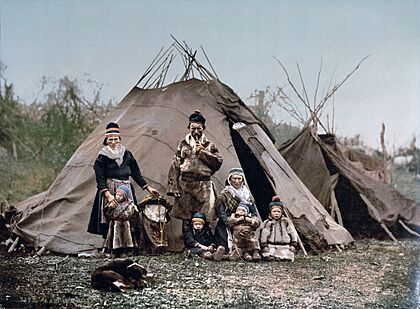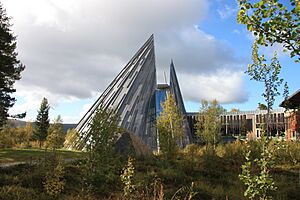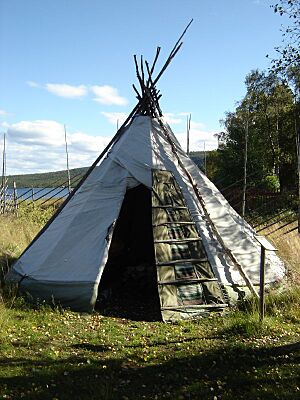Lavvu facts for kids
A lavvu (pronounced LAHV-voo) is a special type of tent used by the Sami people. The Sami live in the northern parts of Europe, in places like Norway, Sweden, Finland, and Russia. This tent is a temporary home, meaning it can be moved easily.
The lavvu looks a bit like a Native American tipi, but it's usually wider at the bottom and more stable in strong winds. It helped the Sami people, who often followed their reindeer herds across the treeless plains and arctic areas. Today, lavvus are still used by the Sami and are also popular for camping trips. It's important not to confuse a lavvu with a goahti, which is another type of Sami dwelling, or the Finnish laavu.
Contents
What is a Lavvu?
The lavvu is a traditional shelter that has been used by the Sami people for hundreds of years. It's designed to be strong and easy to set up, which was perfect for people who needed to move often.
Building a Traditional Lavvu

Building a traditional lavvu involves using several wooden poles. Here's how it works:
- First, three or more strong poles with a fork or notch at the top are used. These poles are connected to form a sturdy tripod.
- Next, about ten or more straight poles are leaned against this tripod. These poles create the round shape of the tent.
- The lavvu doesn't need stakes or ropes to hold its shape or keep it stable. Its design, using many poles, makes it very strong on its own.
- The size and shape of the lavvu depend on how many and what size poles are used.
- There is no single pole in the middle supporting the entire structure.
This way of building a lavvu has been known since at least the 1600s. The goahti, another Sami tent, uses a different pole setup, often with curved poles that are harder to find and carry.
Lavvu: Then and Now
In the past, lavvus were covered with reindeer hides. These hides kept the people inside warm and protected from the weather. Around the mid-1800s, things changed. New, affordable fabrics from factories became available, and the Sami started using these textiles for their lavvu covers instead of hides.
Today, you can find both traditional and modern lavvus. Modern lavvus are designed to be even easier to carry and set up.
- Instead of heavy wooden poles, they often use lightweight aluminum poles.
- The covers are made from lighter, more durable fabrics.
- Some modern lavvus even have small ovens inside for heating, which creates less smoke than an open fire. However, an oven also means less light inside.
These modern lavvus are a popular choice for camping because they are easy to transport and set up quickly. Some very large lavvus exist too, big enough for many people, often used by large families or for community gatherings.
The Lavvu as a Cultural Symbol
The lavvu has always been a very important symbol for the Sami people. It represents their culture, their home, and their way of life. It has played a special role in their history.
For example, after World War II in 1944-1945, many homes in northern Norway were destroyed. Because of this, many Sami families lived in lavvus for years while they rebuilt their lives. Some Sami people alive today were even born in these temporary lavvu homes and have warm memories of them.
The lavvu also became a symbol during the Alta controversy in Norway from 1979 to 1981. This was a time when Sami people protested a plan to build a dam. The dam would have flooded important land where Sami herders grazed their reindeer and would have affected a Sami village. A lavvu was set up in front of the Norwegian Parliament building, becoming a central point for the protest. This protest helped bring attention to Sami rights and led to important laws, like the Sami Act of 1987. This act helped create the Sámediggi (Sami Parliament) in 1989, which is a democratically elected body that works for the Sami people's interests in Norway.
The strong meaning of the lavvu can also be seen in the coat of arms of Kautokeino Municipality, which features a lavvu. The building for the Sámediggi itself was designed to look like a lavvu, showing its deep cultural importance.
Life Inside a Lavvu Tent
Inside a lavvu, there is usually a fireplace in the middle. This fire provides warmth and helps keep mosquitoes away. The smoke from the fire escapes through a special opening, called a smoke hole, at the very top of the lavvu.
To make sure the smoke goes out properly, there needs to be good air circulation. This is often achieved by leaving a small gap between the ground and the bottom edge of the lavvu cover, or by keeping the door slightly open. It's also important to keep the fire hot enough so that the warm smoke rises and leaves through the smoke hole.
Traditionally, some lavvus had a smaller, second door at the back, opposite the main entrance. This was sometimes called the bear door and was used for special traditional ceremonies. Today, most lavvus do not have this second door.
Other Tents Like the Lavvu
Many cultures around the world have developed unique tent designs. Here are a few that share some similarities with the lavvu:
- Tipi: This tent is used by some Native American groups. While it looks similar to a lavvu, it has a slightly different shape and pole structure.
- Chum (tent): Used by people in northern Siberia and the Ural Mountains, the chum is similar in design to a lavvu, but often much larger. Some people still use chums as their homes all year round.
- Goahti: This is another type of Sami dwelling. It is often confused with a lavvu, but it has a different pole structure and is usually more stretched out and lower to the ground. In some old photos, you can see both a goahti and a lavvu side-by-side.
- Kohte: This is a traditional German scouting tent. It was inspired by the lavvu but is typically black in color.
See also




